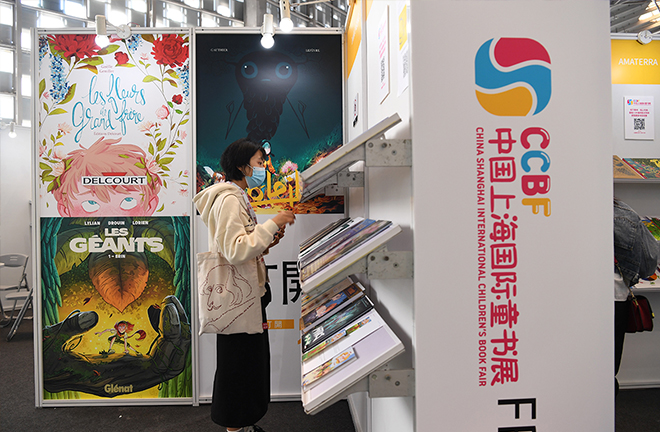Children’s literature translation shows unique features

The China Shanghai International Children’s Book Fair in Shanghai Photo: CFP
As a branch of literary translation, children’s literature translation has its own particularities on the basis of following the general rules of translation. Since children’s literature mainly targets children, its translation needs to conform to children’s reading habits. In recent years, the overall study of children’s literature translation has been on the rise, but there still remains a great deal of room for improvement in terms of theoretical explorations and disciplinary construction.
Childishness and literariness
Children’s literature translation is a huge treasure, as quality works can create a fresh and gorgeous literary world for children, and open a window for them to know and feel the world. Therefore, translators should feel certain childishness from a childlike perspective in the translating process. According to Zhu Ziqiang, vice president of the China Society for the Studies of Children’s Literature, since the translation of children’s literature is about “children’s” literature, its values should be based on children.
The particularity of children’s literature translation results from the generation gap between translators and readers, said Wu Xiangyu, director of the Research Center of Children’s Literature at Zhejiang Normal University. Communication and exchange between the two generations of translators and readers brings challenges to children’s literature translation. Essentially, children’s literature translation is about how to achieve coherent and effective connections between the source language and the target language. It is a cultural endeavor with dual attributes of “childishness” and “literariness.”
The first priority of children’s literature translation is childlike innocence and the second is accuracy, said Yang Peng, an associate research fellow from the Institute of Literature at the Chinese Academy of Social Sciences. The heart of children’s literature consists of a childlike mind, childlike interest, and childlike simplicity: elements suitable for children to read. On the basis of ensuring a childlike nature, translators should strive to achieve accuracy and reproduce the source text’s writing style, personal traits, artistic beauty, sense of humor, literariness, and locality. Only in this way can children’s literature translation be vitalized.
Being endearing to children is the lifeline of children’s literature translation, said Xu Derong, a professor from the College of Foreign Languages at Ocean University of China. In order to achieve this goal, the translator should attend to the accuracy, readability, and literariness of children’s literature translation, which are the standard and basic criteria of children’s literature translation criticism.
Interestingness
Attention should also be given to the interestingness of translated works, Xu added. In nature, children’s literature translation rejects abstruse wording, and also dislikes flat and tasteless language. The language of children’s literature is closest to poetry, which can be said to have a natural “poetic” quality: plain, flavorful, and powerful. Fully grasping the style and features of the source text and effectively regenerating it in the target text is the key to adding interest to children’s literature translation.
According to Wu, children’s literature translation is not rigidly limited to the translation ethics of “faithfulness,” but should instead conduct various forms of language rewriting and adaptation in light of specific cases. Thus there appear many examples of “creative rebellion” in translation.
Translators should not only be captivating, but also convey the inner connotations of the work. Zhu once translated a Japanese picture book for infants and young children into Chinese, which, if translated literally, would have been named The Crocodile Called the Crocodile Goes to Take Baths. Actually, he translated the title into The Crocodile Mr. Croco Loves Taking Baths. Compared with the literal translation, the title enhances the linguistic rhythm and interest, and is closer to the image of the playful crocodile in the picture book.
Theoretical progress needed
The study of children’s literature translation has long been on the margins of translation studies and thus needs to be strengthened, Xu added. A broad vision and interdisciplinary consciousness is required. As research on children’s literature translation is naturally closely related to literary criticism, historiography, psychology, cognitive science, and other disciplines and fields, it is necessary to broaden and deepen studies from various dimensions.
At present, domestic translators’ remuneration is relatively low, and most of them are paid according to the word count. Yang suggests that increasing remuneration for children’s literature translation by connecting it to copyright royalties will motivate the enthusiasm of translators and attract more excellent translators into the industry.
Scholars should affirm the subject position of children’s literature translation in the history of translated literature, expand interdisciplinary mutuality between children’s literature translation and children’s literature studies, and highlight the unique contribution of children’s literature translation to the development of modern society. Wu suggested that the study of children’s literature translation proceed from the dual perspectives of “nationality” and “modernization.” In the meantime, scholars are expected to advance the ontological studies of children’s literature translation resting on “China,” “children,” and “literature,” so as to provide strong theoretical resources for the “bringing in” and “going out” of children’s literature.
In Zhu’s opinion, the quality has yet to catch up with the quantity of research achievements on children’s literature translation in China. Scholars seem to be stuck more in phenomenological descriptions than profound theoretical interpretations.
Edited by YANG LANLAN
